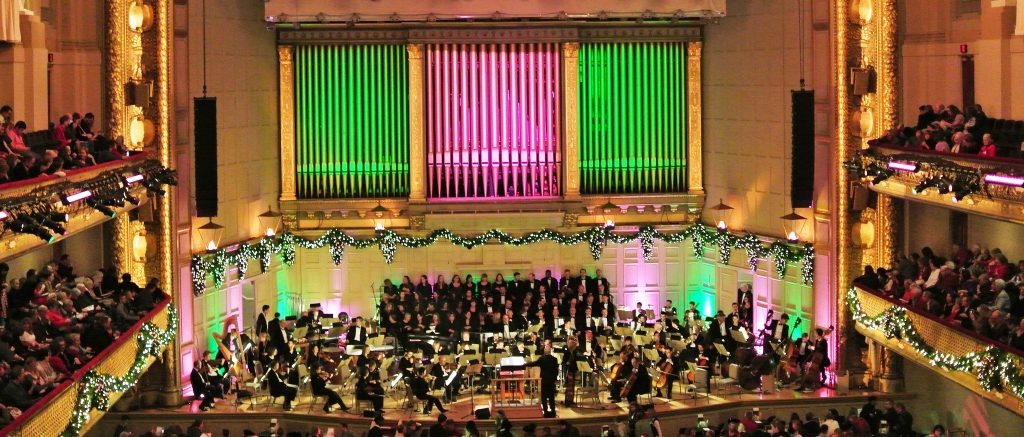Get to Know Your Orchestra Posted by Gary Locke on Nov 17, 2016 in Culture, English Vocabulary

As the holidays approach, symphonies around the U.S. get a little less serious.
One of the great treasures of any community is its musicians. In the United States you will find bands, orchestras, philharmonics, symphonies, and ensembles of all sizes playing every weekend. Most towns have some form of a brass or jazz band in their high school. The same is true of colleges and universities. The skill and knowledge gained there is something that individuals carry with them throughout their lives. Practice is essential, of course, but if you can play a musical instrument, chances are that you can perform somewhere nearby on a fairly regular schedule.
The word orchestra is a broad term for any size group of instrumentalists (with an emphasis on strings) who play together. It comes from the Greek word ὀρχήστρα, meaning the front part of the theater where the Greek chorus performed. There are essentially three types of classical orchestras:
- String orchestras, which consist entirely of string instruments
- Chamber orchestras, which are small orchestras of about 20 – 50 members, and usually play in small venues
- Full orchestras, which may be called symphonies or philharmonics, consisting of up to as many as 100 members or more, and play in concert halls
Chamber orchestras take their name from chambre, the French word for room, and they can perform pretty much anywhere. You may find a chamber orchestra playing in a large concert hall, assuming that the acoustics are good enough, but full orchestras cannot fit in any venue other than large halls.
You may be wondering what the difference is between a philharmonic and a symphony. Well, really, there isn’t one. Both words mean the same thing – harmonious music. The two terms are sometimes used when a community or city has more than one full orchestra to distinguish between them, such as the Seattle Symphony Orchestra, and the Seattle Philharmonic.
Finally, there is one other kind of orchestra – The Pops!
During the summer months, and from late November to early in the New Year, orchestras in many communities in the U.S. perform “lighter” pieces of music from the classical repertoire, as well as popular tunes and music from the stage and screen. Masterpieces like Mahler’s Fifth Symphony or Dvorak’s New World Symphony are set aside and replaced by Rossini overtures and tunes from Gilbert and Sullivan. Broadway stars and singers never associated with classical music and opera take the stage with some of the world’s finest “serious” musicians.
In many ways, this is an attempt to broaden the appeal of classical music – to make it more accessible to people who generally wouldn’t listen to anything beyond rock, country, and/or jazz. When people are on vacation, or out with their family celebrating the holidays, they don’t want to work hard trying to appreciate complex and demanding compositions. Something that makes them tap their feet, or sing along, is better suited to their moods.
Many cities have Pops orchestras. Some orchestras, like the Detroit Symphony, have Pops concerts, but many Pops orchestras operate separately from their parent organizations. There is usually some crossover in personnel, but many musicians work exclusively for their Pops orchestra. And, while not exclusively an American concept, there are far more of them in the United States than in any other country. The New York Pops and The Cincinnati Pops are enormously popular, and have enjoyed considerable success with recordings over the years. For many, though, the most widely recognized is The Boston Pops.
The Boston Pops is over 130 years old, formed out of the Boston Symphony Orchestra by their founder, a Civil War infantry officer. The summer concerts were initially called promenade concerts and later more commonly known as popular concerts, which became shortened to Pops. The formal name was adopted in 1900. The next year they moved into Symphony Hall, their permanent home, which was designed to have perhaps the greatest acoustics of any performance hall in the country. It also, for the sake of Pops concerts, has removable seats in the lower section which are replaced by tables and chairs. Concert goers can enjoy light dining and wine and cocktails as they enjoy the music. Dancing has been known to break out.
Under conductor Arthur Fiedler, who held the lead baton for 50 years, the Boston Pops became the most recorded orchestra in America. Mixing popular tunes with new compositions and a wide mix of lesser known classical pieces, the Boston Pops gained the enviable sobriquet of “America’s Orchestra”. Fielder introduced a tradition of outdoor concerts for the 4th of July, America’s Independence Day, which are nationally televised.
There was concern that the popularity of the Boston Pops would suffer when Fiedler passed away, but that concern was short-lived when the maestro was succeeded by John Williams. Williams is, by far, the most acclaimed film composer in history, with more Academy Award nominations than anyone. Celebrities were eager to perform with the Pops when he was conducting. His film scores became regular features of the Pops repertoire, and continue to be to this day, now under the baton of the charismatic Keith Lockhart.
Today, as we move into the holiday season, Pops orchestras from Boston to Toronto to Melbourne are preparing concerts of Christmas favorites. Singalongs of carols and pop standards will entertain millions. Sleigh bells, hardly standard instruments for performances of Mozart or Bach, will ring out in concert halls near and far. And don’t be surprised if you see Santa Claus conducting an orchestra or two.
Photo by Lorianne DiSabato on Flickr

Build vocabulary, practice pronunciation, and more with Transparent Language Online. Available anytime, anywhere, on any device.



